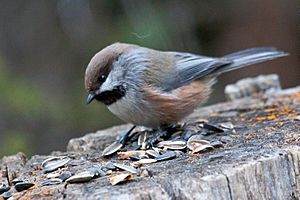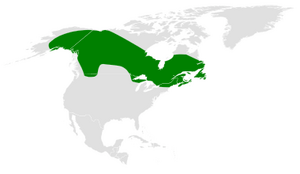Boreal chickadee facts for kids
Quick facts for kids Boreal chickadee |
|
|---|---|
 |
|
| Conservation status | |
| Scientific classification | |
| Genus: |
Poecile
|
| Species: |
hudsonicus
|
 |
|
| Range of Poecile hudsonicus | |
| Synonyms | |
|
Parus hudsonicus |
|
The boreal chickadee (Poecile hudsonicus) is a small, fluffy bird. It belongs to the tit family, called Paridae. You can find these birds in the cold, northern forests. They live in Canada and the northern parts of the United States.
Contents
What Does a Boreal Chickadee Look Like?
Boreal chickadees are small birds. They are about 12.5 to 14.5 centimeters (5 to 5.7 inches) long. They weigh between 7 and 12.4 grams (0.25 to 0.44 ounces). That's about as much as a few paper clips!
Their upper parts are grey-brown. They have a brown cap on their head. Their wings and tail are grey. The sides of their face are white, with mostly grey in the middle. Their belly is white, but their sides are brown. They also have a black patch on their throat.
Boreal chickadees have a short, dark beak. Their wings are short, and their tail is long with a small notch. You might hear their call, which sounds like a husky tsik-a-dee-dee. This call is why these birds are called "chickadees"!
Where Do Boreal Chickadees Live?
These birds live in conifer forests. These are forests with trees like pine, spruce, and fir. You can find them across Canada and in Alaska. They also live in the northern parts of the United States.
Boreal chickadees usually stay in the same area all year. They don't often fly south for winter. This means they are very good at living in cold, snowy places!
How Do Boreal Chickadees Behave?
Boreal chickadees are busy birds. They look for food on the branches of conifer trees. They also poke their beaks into the tree bark. They mostly eat insects and seeds. Sometimes, they hide food to eat later. This is called "caching."
In winter, they often join small groups of other birds. These groups are called mixed-species feeding flocks. This helps them find food and stay safe together.
Nesting and Reproduction
Boreal chickadees build their nests in holes in trees. Both the male and female bird help dig out the nest. They might use a natural hole or an old woodpecker nest.
The female bird lays about five to seven eggs. The eggs are white with small reddish-brown spots. Once a pair mates, they often stay together for their whole lives. They also stay together all year round.
See also
 In Spanish: Carbonero boreal para niños
In Spanish: Carbonero boreal para niños


